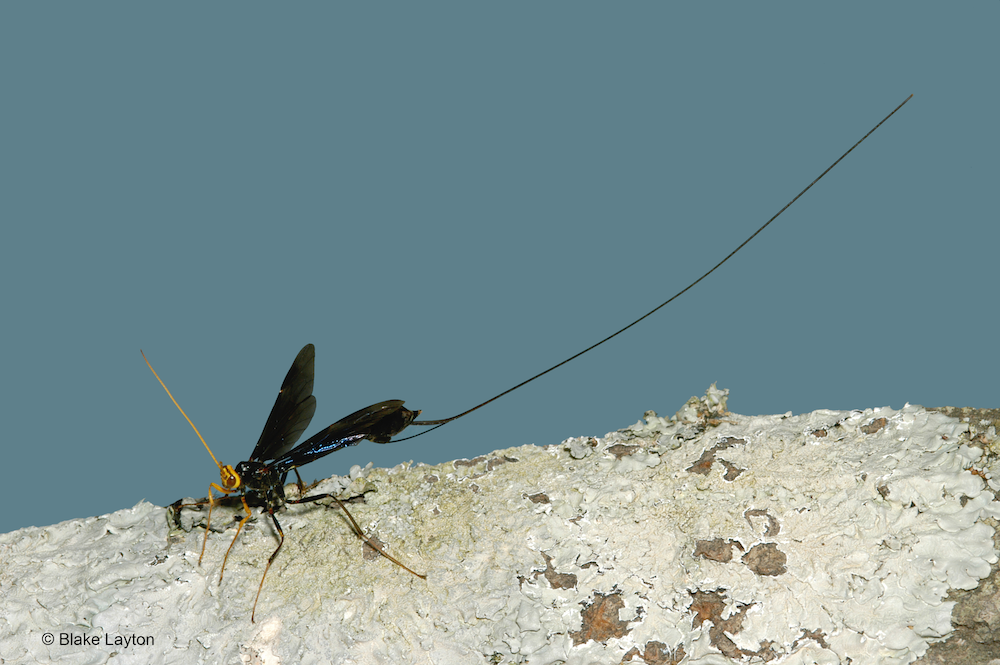Black Giant Ichneumon Wasp, Vol. 7, No. 30
Megarhyssa atrata
Order: Hymenoptera
Family: Ichneumonidae
This wasp has a 4-inch stinger and can drill through several inches of hardwood to get to its prey. Fortunately, it does not sting people and is only interested in laying its eggs in the larvae of another woodboring insect.
Giant ichneumon wasps are some of the largest parasitic wasps in the state, second only to cicada killer wasps. And if you measure by length, rather than weight, they have cicada killers beat. A large female can be over 2 inches long with an ovipositor that measures an additional 4 inches or more. A female black giant ichneumon wasp is shown here. Megarhyssa marcrurus, is similar in size, but is brown and yellow, colored much like a Guinea wasp.
If you see one of these crawling on a log in search of a host, you might think they are parasites of woodboring beetles. After all, most of the large larvae found boring in dead trees and logs are the immatures of wood-boring beetles. But giant ichneumon wasps specialize in parasitizing the larvae of another unusual group of large wasps, known as wood wasps, or horntail wasps. Wood wasps have an impressively large, sturdy ovipositor of their own, though not nearly so long as the ichneumon wasps, which they use to insert their eggs into trees and logs. The resulting wood wasp larvae feed as wood borers, pupate inside the wood, and ultimately emerge as adults—unless they are parasitized by an ichneumon wasp. One particular species of wood wasp, the pigeon tremex, is the favored host of M. atrata.
Sometimes there is a debate over whether that long stylus of female ichneumon wasps is a stinger or an ovipositor. It’s both. These wasps do sting, and the sting is deadly, but only to wood wasp larvae. The long ovipositor consists of three filaments, two of which form a protective cover for the horsehair-thin, hollow filament in the center. This is the part that drills into the wood with the aid of special wood-digesting enzymes and deposits the egg in the host gallery. Eggs are unusually long and flexible to allow them to pass through the tiny diameter of the ovipositor.
Female ichneumon wasps can sense wood wasp larvae feeding deep inside a log, possibly by hearing them chew, and precisely target them by drilling through the wood with their ovipositor. Once they have drilled into the gallery where the wood wasp is feeding, they inject the larva with a paralyzing venom, then withdraw the ovipositor from the host and deposit an egg nearby. The resulting ichneumon wasp larvae feeds on the paralyzed wood wasp larvae as an ectoparasite, meaning that it remains outside the body of its host, pupates within the gallery when mature, and emerges as an adult the following spring. Although they resemble the females, male giant ichneumon wasps have long slender abdomens with no ovipositor.
Where would you most likely see one of these amazing wasps? The same place you might see an adult wood wasp, on or around dead hardwood trees or logs. Neither wood wasps nor giant ichneumon wasps are very common. These are insects most people might only see a few times in their life, but they are out there in our woods, leading lives that are uncommonly strange, complex, and interesting.
Blake Layton, Extension Entomology Specialist, Mississippi State University Extension Service.
The information given here is for educational purposes only. Always read and follow current label directions. Specific commercial products are mentioned as examples only and reference to specific products or trade names is made with the understanding that no discrimination is intended to other products that may also be suitable and appropriately labeled.
Mississippi State University is an equal opportunity institution.
Bug’s Eye View is now on Facebook. Join the Bug's Eye View Facebook group here.


